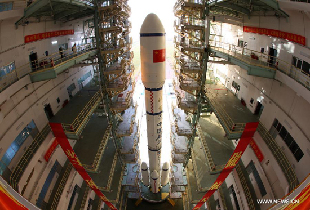
A Long March 2F carrier rocket loaded with "Tiangong-1", China's unmanned space module, is moved to the launch pad at the Jiuquan Satellite Launch Center in northwest China's Gansu Province, Sept. 9, 2011.
Last-minute preparations for the launch of the Tiangong-1 spacecraft began at the Jiuquan Satellite Launch Center on Monday, meaning the vehicle can soon embark on a mission that will eventually have it dock with a spaceship, according to the center.
That feat, if carried out successfully, will mark the completion of China's first rendezvous and docking mission.
At the launch site on Monday afternoon, crews were putting in place pipes and cables that will be used to inject fuel into the rocket that will carry Tiangong-1 into outer space.
Without complications from the weather or other causes, the Long March II-F rocket will lift off from the launch center on Thursday or Friday, taking the Tiangong-1 with it, according to the Xinhua News Agency.
Despite the preparations, space experts said carrying out the plan still comes with many risks. They explained that the spacecraft and much of the other equipment being used is new and has not been tried on an actual mission.
"Tiangong-1 is a brand new spacecraft designed by China and is bigger and heavier than the Shenzhou spaceships China had developed as a means of transporting astronauts from the Earth to space," said Yang Hong, chief designer of Tiangong-1.
In a vertical position, the Tiangong-1 looks like a cigar standing 10.4 meter tall, a height equal to that of a three-story building. It weighs 8.5 tons and has a maximum diameter of 3.35 meters, a dimension shared by its launch vehicle, he said.
In comparison, the Shenzhou spaceship stands shorter, at nearly 9 meters, is slimmer, having a diameter of less than 3 meters, and weighs less.
In another difference, the Tiangong-1 is composed of two modules rather than the three that had made up the Shenzhou spaceship. Of the Tiangong-1's two primary components, one is an experimental module that contains a place that astronauts can live and work in on future missions. It is also equipped with a docking port.
The other chief component, a resource module, will provide the craft with power.
Astronauts on Tiangong-1 will have 15 cubic meters of space to move in, "much more than they had in the Shenzhou spaceship", Yang said.
Inside the spacecraft are two sleeping sections with adjustable lighting systems, exercise equipment, entertainment systems and visual communication devices, he said.